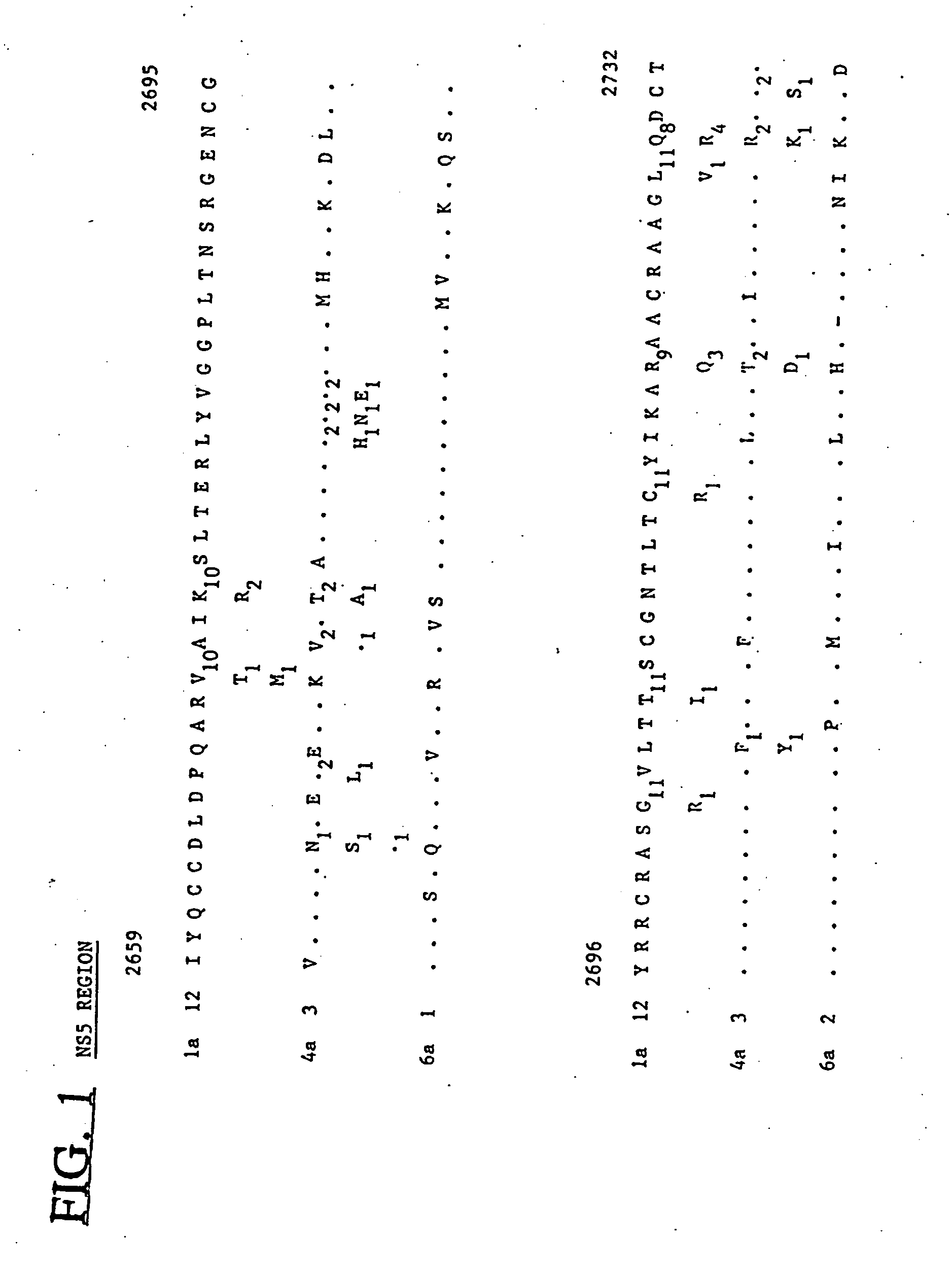Hepatitis-C virus type 4, 5 and 6
a hepatitis c virus and a new type of technology, applied in the field of new elucidation sequences of hepatitis c virus type 4 (hcv4), can solve the problems of unreliable antibodies, false positive reactions of second-generation elisa tests, and lack of specificity of c100-3 antibody tests for hepatitis c virus, etc., to achieve the effect of facilitating detection
- Summary
- Abstract
- Description
- Claims
- Application Information
AI Technical Summary
Benefits of technology
Problems solved by technology
Method used
Image
Examples
example 1
HCV-4 and HCV-6: NS5 Region Sequences
[0067] Samples. Plasma from a total of 16 HCV-infected blood donors in Scotland, Egypt and Hong Kong and from a patient with chronic hepatitis in Lebabon were used for analysis of NS5 sequences of types 4 and 6.
[0068] Nucleotide sequence analysis. To obtain sequences in the NS5 region, viral RNA was reverse transcribed and amplified by polymerase chain reaction (PCR) in a single reaction with previously published primers thought to be highly conserved amongst different variants of HCV (Enomoto et al. (1990) Biochemical and Biophysical Research Communications 170:1021-1025). For some sequences, a second PCR was carried out with primers 554 and 555 (Chan et al. (1992) J. Gen. Virol. 73:1131-1141) in combination with two new primers, 122 (sense orientation; 5′ CTC AAC CGT CAC TGA GAG AGA CAT 3′) (SEQ ID NO:51) and 123 (anti-sense; 5′ GCT CTC AGG TTC CGC TCG TCC TCC 3′) (SEQ ID NO:52). Product DNA was phosphorylated, purified and cloned into the Sm...
example 2
HCV-4, -5 and -6; NS4 Region Sequences
[0069] Attempts have been made to isolate DNA sequences from the NS4 region of Hepatitis C virus (HCV) types 4, 5 and 6 using PCR amplification. The decision was made to use primers which contained restriction sites, thereby allowing the cloning of the PCR products via cohesive end cloning. New primers were also designed from relatively conserved regions of the HCV NS4 gene. The cloning strategy involved several particular steps, as follows.
[0070] (i) Klenow repair. The termini of the amplified DNA were repaired with Klenow DNA polymerase to ensure that the ends which contained the restriction sites were complete.
[0071] (ii) Kinasing of termini. The PCR product termini were phosphorylated using T4 polynucleotide kinase. This allowed self-ligation of the products in a concatemerization step.
[0072] (iii) Concatemerization of the PCR products. The DNA fragments were ligated together to form long concatemeric arrays. This step internalized the r...
example 3
Synthesis of NS4 Peptides
[0103] The following peptides within the NS4 region of HCV types 1 to 6 were synthesized. Types 4 to 6 are novel sequences according to the present invention, whereas types 1 to 3 are presented for comparison purposes and use in a complete HCV serotyping assay.
(SEQ ID NO:26)HCV type 1 [H2N-KPAIIPDREVLYREFDEM]8K4K2K-COOH(MDL031)(SEQ ID NO:24)HCV type 1 [H2N-KPAVIPDREVLYREFDEM]8K4K2K-COOH(MDL033)(SEQ ID NO:53)HCV type 1 [H2N-RPAVIPDREVLYQEFDEM]8K4K2K-COOH(MDL036)(SEQ ID NO:54)HCV type 1 [H2N-RPAVVPDREVLYQEFDEM]8K4K2K-COOH(MDL035)(SEQ ID NO:55)HCV type 1 [H2N-ECSQHLPYIEQGMMLAEQF]8K4K2K-COOH(MDL037Q)(SEQ ID NO:56)HCV type 1 [H2N-ECSQHLPYIEQGMALAEQF]8K4K2K-COOH(MDL038Q)(SEQ ID NO:57)HCV type 2 [H2N-RVVVTPDKEILYEAFDEM]8K4K2K-COOH(MDL039)(SEQ ID NO.42)HCV type 2 [H2N-ECASRAALIEEGQRIAEML]8K4K2K-COOH(MDL041)(SEQ ID NO:58)HCV type 2 [H2N-ECASKAALIEEGQRMAEML]8K4K2K-COOH(MDL040)(SEQ ID NO.30)HCV type 3 [H2N-KPALVPDKEVLYQQYDEM]8K4K2K-COOH(MDL042)(SEQ ID NO.44)HCV type...
PUM
| Property | Measurement | Unit |
|---|---|---|
| size | aaaaa | aaaaa |
| concentration | aaaaa | aaaaa |
| concentration | aaaaa | aaaaa |
Abstract
Description
Claims
Application Information
 Login to View More
Login to View More - R&D
- Intellectual Property
- Life Sciences
- Materials
- Tech Scout
- Unparalleled Data Quality
- Higher Quality Content
- 60% Fewer Hallucinations
Browse by: Latest US Patents, China's latest patents, Technical Efficacy Thesaurus, Application Domain, Technology Topic, Popular Technical Reports.
© 2025 PatSnap. All rights reserved.Legal|Privacy policy|Modern Slavery Act Transparency Statement|Sitemap|About US| Contact US: help@patsnap.com



